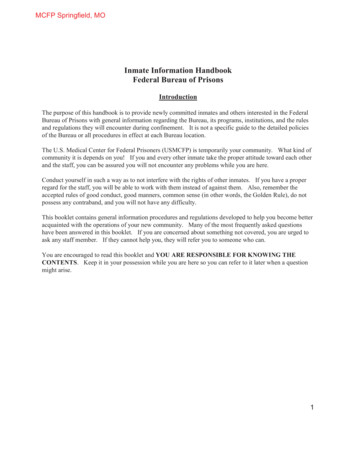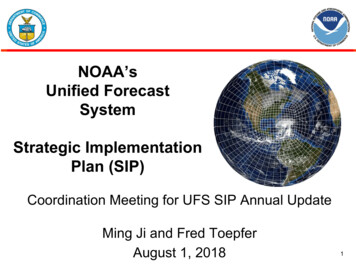
Transcription
DIVISION OF PRISONSSTRATEGIC PLAN2020-2024ADULT CORRECTION & JUVENILE JUSTICETODD ISHEE, Commissioner of PrisonsBRANDESHAWN HARRIS, Assistant Commissioner of Prisons
Message From the CommissionerI am pleased to present this strategic plan for the NorthCarolina Division of Prisons. This plan is a roadmap for theDivision of Prisons to strive to achieve over the next fiveyears.The foundation for this plan came from the input fromline staff in focus groups conducted in 2019. Many of thestrategies included here were formulated during those focusgroups. Leadership worked to hone the ideas and developthis dynamic guide for our actions over the next five years,from 2020-2024.I appreciate everyone who has worked so hard to developthis plan. I believe these goals are specific, measurable,achievable, relevant and time bound. They can be achievedby our extraordinarily dedicated staff, who work so hard tosupport the Department of Public Safety mission to prevent,protect and prepare.Through our shared sense of One Team, One Mission, we can make our prisons safer, enhance our use oftechnology, improve communications, bolster offender rehabilitative programs, advance the health care ofoffenders, and recruit and retain top-notch staff.The plan sets many lofty goals. In particular, we plan to achieve American Correctional Associationaccreditation for all facilities; establish a quality assurance division to thoroughly and routinely review ourpolicies, procedures and practices; and create an Innovation Institute to research evidence-based programsand review best practices across the country and the world that we can adopt.Strategic planning is not a static process; it constantly evolves, but our core values do not. We remain dedicatedto our core values of PRIDE – Protect, Respect, Integrity and Innovation, Duty and Diversity, and Excellence.It is our commitment to you and the citizens of the State of North Carolina, that the Division of Prisons willcontinue to develop our culture and environment of safety, quality, and opportunity for all.
CONTENTSPlanning Process2Core Values / Mission and Vision3Organizational Overview7Goal 1 - Maintain Safe, Secure, Humane & Orderly Institutions10Goal 2 - Improve Technology14Goal 3: Objective 1 - Staff Recruitment17Goal 3: Objective 2 - Staff Retention19Goal 3: Objective 3 - Improve Staff’s Quality of Life21Goal 3: Objective 4 - Enhancement of Staff Wellness Programs and Communication22Goal 4 - Enhance Communications with Stakeholders and Across Disciplines23Goal 5 - Develop, Enhance & Improve EBP and CBI26Goal 6 - Staff Training33Goal 7 - Innovative Delivery of Health Services35Goal 8 - Correction Enterprises Operational Efficiencies42Goal 9 - Correction Enterprises Financial Sustainability43Goal 10 - Fiscal Accountability and Strategic Plan Evaluation44
2020 - 20241STRATEGIC PLAN
STRATEGIC PLAN2020 - 2024THE PLANNING PROCESSFor everyone involved in the strategic planning process, from the planners to those who will be implementing the strategies, we must be confident in our core values, vision, mission and goals. Ifwe are not engaged in implementing the goals as written or modified the plan will be just a stackof paper. But we know no plan can remain static and not grow as we meet new challenges. As implementers of the plan, it is critical each of you let your supervisor know when something is not relevant, attainable or measurable or in other words, when something just does not make sense.During the development process for this plan, there were two meetings of focus groups to developideas. The ideas from these focus groups were reviewed and consolidated. In January 2020, ourleadership team met to review the consolidated ideas from the groups and through a modified SWOTanalysis (Strengths, Weaknesses, Opportunities and Threats) developed a proposed set of core values, aproposed vision and mission statement, and proposed strategic goals for the agency to undertake.After the leadership team completed their work, the Commissioner and his staff reviewed and strengthenedour goals. A group of Subject Matter Experts then worked to develop strategies for the implementation ofour goals for the next five years.2
2020 - 2024STRATEGIC PLANCORE VALUESCore values are qualities which represent an individual’s or an organization’s highest priorities, deeply heldbeliefs, and core, fundamental driving forces. They are the heart of what the Division of Prisons and itsemployees represent.Values form the foundation for everything that happens in the Division of Prisons. The core values of theagency along with our employees, their experiences, upbringing, and beliefs join together to form the cultureof the agency. The essential tenets of the Division of Prisons have at their foundation PRIDE. Our core values:PRIDErotectespectOURCOREVALUESntegrity and Innovationuty and Diversityxcellence3
STRATEGIC PLAN2020 - 2024MISSION and VISIONOur mission statement provides a good understanding of what we are:“ As one team, the Mission of the North Carolina Division of Prisons is toprotect the public and our staff by operating a safe correctional systembased on integrity, innovation, community consistent healthcare,respect and duty to promote excellence throughout our system.”A vision statement provides direction for what we desire to achieve.A vision statement tells everyone where we want to go. It is an essential ingredient to achieve growth in anyorganization as it keeps us attuned to the possibilities of what the future can be. Concisely, mission is now;vision is next.“ The North Carolina Division of Prisons is committed to build a premiercorrectional organization based on integrity, respect, innovation andevidence to provide for the safety of all, while reducing recidivism andpromoting the successful reintegration of our offenders as law-abidingcitizens.”4
2020 - 2024STRATEGIC PLANSTRATEGIC PLANNINGStrategic Planning goals and strategies for achieving them, along with our beliefs (values), practice (mission)and direction (vision) join together to allow us to achieve positive results. If you remove any of the factorscontributing to our culture, the plan will not inspire, but will expire without achieving desired results. Towardthat end,Our Strategic Planning Goals are to:1. Maintain safe, secure, humane and orderly institutions to protect the citizens of North Carolinaand those who work and reside at our facilities.2. Improve technology to enable staff to complete tasks efficiently, communicate effectively andenhance the safety and security of institutions and industries.3. Develop strategies for staff recruitment, retention, morale and wellness.4. Enhance communications across all disciplines and stakeholders fostering interdisciplinarydecision-making.5. Develop, enhance and improve evidence-based programs and cognitive behavioral interventionsto allow for the development of coping skills, reduce recidivism, and provide opportunities forsuccessful transition into our communities.6. Provide for continuing staff training to maintain and enhance technical skills, improvethe supervising of others, develop abilities to lead change, and motivate others all whileunderstanding the conflicting roles presented by corrections.7. Innovate the delivery of health services to allow appropriate access and equity with a communitystandard of care, while recognizing public stewardship responsibilities.8. Maximize operational efficiencies across all Correction Enterprises’ industries.9. Maintain Correction Enterprises’ financial sustainability through increasing the cash balance andretained earnings.10. Evaluate and study each part of this plan for costs to ensure the best efficiencies are realized toenable funding as the result of efficiencies are reallocated.5
STRATEGIC PLAN2020 - 2024Our Values, Mission and Vision when joined together withour planning goals provide the basis of The North CarolinaDivision of Prisons Strategic Plan for 2020 - 2024.CORE VALUESProtect Respect Integrity and Innovation Duty and Diversity ExcellenceMISSION STATEMENTAs one team, the Mission of the North Carolina Division of Prisons is to protectthe public and our staff by operating a safe correctional system based onintegrity, innovation, community consistent health care, respect andduty to promote excellence throughout our system.VISION STATEMENTThe North Carolina Division of Prisons is committed to build a premiercorrectional organization based on integrity, respect, innovation and evidenceto provide for the safety of all, while reducing recidivism and promoting thesuccessful reintegration of our offenders as law-abiding citizens.6
2020 - 2024STRATEGIC PLANORGANIZATIONAL OVERVIEWThe North Carolina Division of Prisons (DOP) confined 36,256 offenders at the end of June 2019 beinghoused at 54 institutions throughout the state. There is a Central Office and four regional offices. Thereare 16,307 positions authorized for the DOP with 14,053 positions encumbered as of June 2020. CorrectionEnterprises which is the prison industries component of the DOP has 29 factories employing 2600 offenders.The institutional population is 30,978 males and 2,247 females. About 70% of offenders have been sentencedunder the Justice Reinvestment Act. Post Release Supervision violators make-up 167 of the prison population.All persons confined in the DOP have been convicted of felonies.FACTORS IMPACTING THIS PLANIn 2017, five members of our Correctional family were killed by offenders at two different institutions.These murders of staff demonstrated deficiencies in security leading to a study by the National Instituteof Corrections and the creation of a Security Accountability Section within the Division of Prisons.The establishment of a Prison Reform Advisory Board made up of experienced prison administratorsby the Secretary of Public Safety which made recommendations to enhance prisons operations andprograms.A decision to seek accreditation by the American Correctional Association (ACA), Commission onAccreditation for Correction over the next seven years (2021 – 2028). We will study the feasibility ofCentral Prison Health Complex and North Carolina Correctional Institution for Women (NCCIW) seekingspecialized health care accreditation.The cultural shift from Correction Enterprises being a unit which worked with the DOP to a componentwhich is an integral part of the management of prisons.The decision to develop quality assurance reviews for each discipline working within the DOP. At thistime, it is planned the guidelines for the following areas will be established: Correctional Services,Correctional Programs, Correction Enterprises, Staff Training, Maintenance, Health Services, AdministrativeProcesses, Information Technology and Cybersecurity, Occupational Health and Safety and Food Serviceand Nutrition.The continuing difficulty of recruiting and retaining correctional personnel with special emphasis givento correctional officers and health care personnel.7
STRATEGIC PLAN2020 - 2024An increase in recidivism rates as recorded by the 2020 Adult Recidivism Report of the NC Sentencing andPolicy Advisory Commission reviewing the 2017 Adult Population. This increase of recidivism occurredwhile the total number of the population decreased. Since FY 2013, the recidivist incarceration rate hasincreased 17 percentage points.An increase in serious prison infractions recorded by offenders released. For 2017, an aggregate 47% ofthe released population reported Class A (most serious) infraction with 69% of those confined for B-1-Doffenses receiving at least one Class A infraction. (Sentencing Commission).An increase in the number of violent offenders confined within the Division of Prisons. The followinggraphic representation from the NC Sentencing and Policy Advisory Commission demonstrates howoffenders have had more violent sentences over the past years. It is important to note that thosesentenced to violent offenses do not necessarily equate to dangerousness.Note for clarification: It is not necessarily an increase in the number of sentences for violent offenses, itis an increase proportion of the prison population with convictions for violent offenses. Violent offenses(Classes A-E) have been a remarkably consistent percentage of overall felony convictions – ranging from11-19% over the past 19 years. The reason they are now representing such a large percentage of theprison population is because other groups have been reduced (misdemeanants, probation revocationsfor low-level offenses, etc.)Number of Violent Offenders in DOP lentSOURCE: NC Department of Public Safety, Division of Adult Correction and Juvenile Justice,Automated System Query (ASQ), Sentencing Commission examination8
2020 - 2024STRATEGIC PLANA projected increase in offender population to 38,613 in 2029 (Sentencing Commission).Many prisons across the state are over 50 years old, with aging infrastructure. Additionally, many facilitiesacross the state are small, “road camps,” which were opened originally to assist with the building of roads.These camps generally are small ( 500 offenders), but because of their individual footprint are expensivefrom a per capita standpoint.The COVID-19 Pandemic which has and will call for significant change in the way our business is managed.Prisons by their nature have close living arrangements. We and every other jurisdiction will need to developplans to quickly assess, contain and mitigate threats presented.A need to enhance supervisor’s training throughout the DOP with an emphasis to retain our staff and tosupport a legacy of correctional excellence.The creation of a North Carolina Prisons Innovation Institute to serve to research best evidence based decisions,review best practices and serve as an initiative incubator to allow staff and stakeholders to creatively developdifferent and new ways where resourcefulness is encouraged and a culture of anticipatory leadership becomethe norm.9
STRATEGIC PLAN2020 - 2024GOAL 1Maintain safe, secure, humane, and orderly institutions toprotect the citizens of North Carolina and those who work andreside at our facilities.Strategy 1.1 — Study methodologies to reduce violence throughout the system, reviewingartificial intelligence and predictive analytics to determine if these methodologies have promise indeveloping policies to reduce violence.Strategy 1.1.1 — Direct the Innovation Institute to study both artificial intelligence modelsand predictive analytics as it relates to a reduction of violence. If the research demonstratesgood results, create recommendations on how to implement them in the DOP.Strategy 1.2 — Enhance staff and offender safety by developing a proactive plan to limit theinfluence of prison gangs on the general prison population.Strategy 1.2.1 — The Operations Director of the DOP will institute a multidisciplinary taskforce with an ultimate goal to proactively manage this population and reduce the violencewhich is often associated with the different prison gangs throughout the system.Strategy 1.2.2 — The multidisciplinary task force will include subject matter experts fromthroughout the system who may have knowledge on how these offenders may be managed.Strategy 1.3 — Create a fleet management position to develop a strategy to determine the life span ofall vehicles which will increase the safety of staff and offenders during transports.Strategy 1.4 — Study the installation of air conditioning at all facilities. Many facilities are notcompletely air conditioned. This presents challenging working conditions for staff and concernsabout the well-being of offenders.Strategy 1.4.1 — Review the facilities without air conditioning to determine at which facilitiesit would be cost prohibitive to install. It is assumed in some locations the cost of installingair conditioning would be more than the value of the building(s).Strategy 1.4.2 — Upon completion of the cost analysis for installation of airconditioning, with the lead from Maintenance, a group will be formed to create aMaster Plan for the DOP.10
2020 - 2024STRATEGIC PLANStrategy 1.5 — Study the purchase and installation of body scanners at all facilities in an effort toreduce contraband.Strategy 1.5.1 — Many institutions may not have space in their gatehouses to house fullbody scanners and fluoroscope technology. A work group with subject matter experts fromMaintenance and Security will review which body scan technologies would be most effectiveand make recommendations for each institution.Strategy 1.5.2 — If there are facilities where it is determined current body scanners are notable to be maintained in front entrances, architectural determinations and alternatives willbe reviewed by the work group to determine if there is a benefit of a capital cost or otheralternatives when reviewing the outcome measure of contraband reduction.Strategy 1.6 — Implement a comprehensive plan for tool control. Currently, an electronicsystem of tool control is being implemented. A comprehensive plan would include the planfor a redundant system for the electronic system.Strategy 1.7 — Seek accreditation of all facilities in a seven-year period to become accredited bythe Commission on Accreditation, American Correctional Association.Strategy 1.7.1 — For Calendar Year 2020, the Central Office of NC DOP, SanfordCorrectional Center, and two Correction Enterprises plants are seeking accreditation.Strategy 1.7.2 — Determine facilities with 24/7 medical care to seek accreditation duringCalendar Year 2021.Strategy 1.7.3 — For years beyond 2021, determine how technology can be used tomeet expected practices of the accreditation agency or how staffing needs will need to berequested (24-7 medical coverage).Strategy 1.8 — Complete a review of recommendations presented by the Prison Reform AdvisoryBoard. A final report will be developed and sent to the Secretary of Public Safety.Strategy 1.9 — Develop an implementation plan to conduct quality assurance audits for disciplinesacross DOP. This plan tentatively includes reviews for Correctional Services, Correctional Programs,Security, Health Services, Food and Nutrition, Administrative Services, Informational Technologyand Cybersecurity, Maintenance, Correction Enterprises, Occupational Health and Safety, and StaffTraining.Strategy 1.9.1 — Select a group of Subject Matter Experts for each discipline determiningwhat is critical and necessary to audit.11
STRATEGIC PLAN2020 - 2024Strategy 1.9.2 — Develop quality assurance audit guidelines for each discipline along withworking papers for auditors to use to demonstrate compliance to the guidelines.Strategy 1.10 — Conduct and publish a comprehensive master plan for the DOP. This plan willassess the age, condition, geography and location of all current assets. The plan should becomprehensive and include among other things: building and renovation recommendations,consolidation recommendations, and human resource considerations.Strategy 1.11 — Develop a comprehensive sustainability plan for the DOP. This plan shouldencompass all different areas across the division with an emphasis on a reduction of energy costsand landfill costs. Provide direction for the sustainability plan with a dedicated staff member.Strategy 1.12 — For those minimum security and medium security facilities not having cameracontrolled perimeter access, obtain cameras and suitable automatic locks controlled by staffassigned to Control Centers to improve perimeter security.Strategy 1.13 — Develop an evaluation of the use of Tasers at close custody facilities to determineempirically if their approved use reduces violence.Strategy 1.14 — Develop incentives for the offender population providing incentive award timefor maintaining good conduct and not participating in violent behavior. A three-year study will beconducted to measure the efficiency and effectiveness of these incentives and determine if theyachieve a goal of safer institutions.12
2020 - 2024STRATEGIC PLANStrategy 1.15 — In a multi-disciplinary endeavor, update our emergency plan for systemwide biological crisis which includes stakeholders from other agencies to provide for the bestmethodologies to identify, contain and mitigate issues identified in the emergency plan. The planshall also address staffing contingencies and equipment necessary to manage all different typesof biological crisis.Strategy 1.16 — Within the Directorate for Standards and Performance, create an Innovation Institutewhose goal will be to study and recommend changes to how parts of the agency may be improvedthrough technology, evidence-based research, documented best practices, and assumption-basedplanning.Strategy 1.17 — Implement Key Performance Indicators (KPI) for each discipline within the DOP.Institutional managers will be trained to routinely use these measures. Performance measures willbe reviewed annually by Innovation Institute and the leadership of the division to determine if theyhave continued relevance. The monitoring of all KPIs should be a performance competency of eachChief Executive Officer. To be effective, each KPI needs to have a benchmark of acceptability toguard against mediocrity against the mean.Strategy 1.17.1 — A forward thinking working group will be established which will usescenario planning and assumption-based planning will develop strategies for managing the“what ifs.”Strategy 1.18 – Collaboration between sections and developing direction for staff to developdivisional focus rather than discipline focus.Strategy 1.18.1 — Develop mechanisms to provide education for staff on the differencesof policy, procedure and information and the analysis of policy development and policyimplementation.Strategy 1.18.2 — Under the direction of the Innovation Institute, conduct a yearly analysisof representative policies which have been published, and report areas of concern as well asareas of success to the Director of Performance and Standards.13
STRATEGIC PLAN2020 - 2024GOAL 2Improve technology to enable staff to complete tasks efficiently,communicate effectively and enhance the safety and securityof institutions.Strategy 2.1 — Ensure all DOP employees have access to DPS-issued email address.Strategy 2.2 — Provide Identification Cards to volunteers for tracking purposes. These volunteercards would be similar to staff identification cards and would provide an accounting of all staff whowere present in the institution through electronic screening.Strategy 2.3 — Purchase additional hand-held metal detectors and ear pieces for hand heldradios.Strategy 2.4 — Provide tablets for Wardens, Associate Wardens and Officer in Charge to documentmanagement staff making rounds in all areas of the institution. This would allow for management staffto document unannounced Prison Rape Elimination Act rounds as required by PREA Standard 115.13 (d).The use of tablets will also allow executive staff to photographically document and delegate to appropriatestaff issues which require action.Strategy 2.4.1 — With the expansion of the telecommunications contract developmethodologies to work with the company to pursue meaningful security enhancements andto assist staff in the performance of their duties.Strategy 2.5 — Develop program curriculum for the use of tablets provided to offenders. Thegoal is to provide educational and other programming targeting the offender audience with morespecificity. Emphasis to be provided for offender’s most in need as determined by evidence.Strategy 2.5.1 — Develop a needs assessment to determine the programming for eachcustody level.Strategy 2.5.2 — Install tablets and program curriculum at a minimum, medium and closefacility to evaluate effectiveness.14
2020 - 2024STRATEGIC PLANStrategy 2.6 — Use video conference capabilities to implement court hearings using technology.The purpose of the strategy is to reduce staffing cost and to provide for the safety of the public andthe Court(s). This is consistent with the Chief Justice’s recent statements on the use of technology.It is analogous with DPS Strategic Initiative 2.3.2.Strategy 2.6.1 — With the cooperation of the Administrative Office of the Courts, develop apilot project with urban and rural court districts to determine the feasibility of holding courthearings using video-conferencing technology.Strategy 2.6.2 — Complete an ABC cost accounting of those court districts participatingdetermining true cost of the use of the technology.Strategy 2.7 — Provide all DOP facilities with wireless internet capabilities (Wi-Fi) to implementadditional technologies to include tablets, portable cameras, location-based “man-down” staffprotection alarms and portable telehealth terminals. Reference Strategy 2.5.Strategy 2.7.1 — Complete an infrastructure analysis of facilities not having secure Wi-Fi todetermine what requirements need to be met to actualize this strategy.Strategy 2.8 — Complete a workload analysis of Electronic Technicians throughout the system todetermine if there is a need for more personnel to meet the increasing complexity of electronicsystems in DOP.Strategy 2.8.1 — Review benchmarks of other Department of Corrections (DOC) todetermine how they analyze the need for electronic technicians.Strategy 2.8.2 — If data is not available from other DOCs to provide enough requisiteinformation to analyze, expand the search to other governmental agencies.Strategy 2.9 — Purchase and distribute Wi-Fi cameras to be used by facilities for the monitoringof blind spots and also to be used to monitor those offenders who are on watch for SIB/SuicideWatch precautions. Such monitoring should be managed in a manner consistent with Prison RapeElimination Act (PREA) Standard 115.15.Strategy 2.10 — Enhance the use of electronic media, such as electronic bulletin boards, throughoutDOP to increase information sharing with staff and offenders.Strategy 2.10.1 — Ask facilities not having appropriate electronic media to select locationswhere such devices would be seen and read by the most people.Strategy 2.10.2 — Determine the best location to set up electronic media for offenders,which will vary by institution.15
STRATEGIC PLAN2020 - 2024Strategy 2.11 — Pilot a program of video visitation at three facilities in the DOP to evaluate if itreduces contraband found to enter facilities through in-person visits and if such a program increasesthe number of visits which an offender receives.Strategy 2.11.1 — Develop evaluation criterion to measure the reduction of contraband.Strategy 2.11.2 — Develop criterion to determine if video visitation provides more visitingtime for offenders and if so, the category of offender.Strategy 2.11.3 — Provide criteria for video visitation for offenders housed in long-termhealth care beds and those in palliative care.Strategy 2.12 — Upgrade and improve technology at Correction Enterprises’ plants, improveoffender access and training on software/technology, establish a leading-edge Enterprise ResourcePlanning (ERP) system, and maintain technology/equipment to stay competitive.Strategy 2.12.1 — Implement iNet (Offender Network Solution) system-wide to provideoffenders viable training opportunities with technology.Strategy 2.12.2 — Implement a modern ERP system that includes a Customer RelationsManagement (CRM) system.Strategy 2.12.3 — Modernize Correction Enterprises’ website to improve functionality,customer accessibility and ease of purchase.Strategy 2.12.4 — Maintain manufacturing technology/equipment to be competitive withthe private sector and provide offender training on the latest technologies.Strategy 2.12.5 — Implement modern order payment processes and methods.Strategy 2.13 — Continue and enhance methods to change the organizational culture to haveCorrection Enterprises as an integral part of prison management.16
2020 - 2024STRATEGIC PLANGOAL 3Develop strategies for staff recruitment, retention, moraleand wellness.Goal 3 incorporates 3.2.7 of the DPS Strategic Plan. It also incorporates3.2.11. The overall strategy for Goal 3, is the collection and analysis ofdata to assess recruitment, retention, morale and wellness. This analysisshould lead to the development of Key Performance Indicators in eacharea as mentioned in Strategy 1.14. The monitoring of all KPIs should bea performance competency of each Chief Executive Officer. To be effective,each KPI needs to have a benchmark of acceptability. All KPIs should bereassessed yearly to guard against mediocrity toward the mean.17
STRATEGIC PLAN2020 - 2024OBJECTIVE 1: Develop staff recruitment strategies to reachevery gender, race and ethnicity within the community eachprison serves and as importantly, develop strategies to retainstaff once they are recruited and hired.Strategy 3.1 — Hire the right staff. Review the interview questions with an emphasis on integrityinterviewing (Reid & Associates), adding credit questions to assist in determining a candidate’slikelihood of being compromised because of monies owed.Strategy 3.2 — Evaluate the possibility of adding a physical abilities test for correctional officerscommensurate with their job requirements. Study the tests given by other jurisdictions.Strategy 3.3 — Develop procedures to conduct an analysis of social media presence for allcandidates prior to the interview and procedures on how to use the information found duringa media review.Strategy 3.4 — Make the application process easier. Use technology to forward necessary paperworkto the Regional Employment Office, but have candidate work exclusively with institution personneloffice. This is consistent with DPS Strategic Initiative 3.2.14.Strategy 3.5 — Improve Pay and BenefitsStrategy 3.5.1 — Continually review salaries of others who employ detention and correctionalofficers to ensure that salaries are competitive.Strategy 3.5.2 — Develop a step-pay increase plan so that
I am pleased to present this strategic plan for the North Carolina Division of Prisons. This plan is a roadmap for the . Division of Prisons to strive to achieve over the next five years. The foundation for this plan came from the input from . line staff in focus groups conducted in 2019. Many of the










